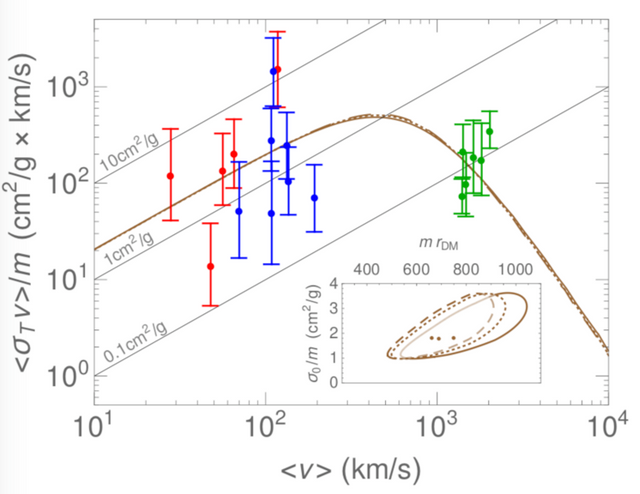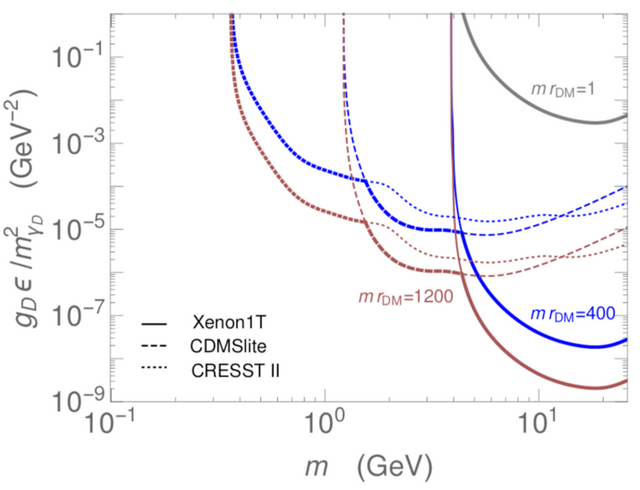Puffy dark matter to reconcile observations and predictions
As always, it turns out that I am busier than expected, and that I have less and less time to post on this blog. However, I am still around. To celebrate this (yeah… really :p), here is a new article on dark matter.

[image credits: Activedia (Pixabay)]
It originates from a scientific article that I have recently read and that introduces the concept of puffy dark matter.
In this article, the three authors propose a new model of dark matter, compatible with the fact that dark matter must explain a large set of cosmological data but has not been found yet.
The key point relies on a dark matter particle that has a non-zero finite size (it is thus not a point-like particle). They have coined their model puffy dark matter. Let us dig into this!
Dark matter 101
Let us first summarize a little bit the motivation behind the idea of dark matter.

[image credits: NASA (public domain)]
The first mention of dark matter as we know it today dates back from the 1930s, when it has been introduced to explain the motion of stars in the galaxies.
At that time, it has been found that at large distances from the galactic centers, stars were moving faster than predicted.
The Swiss astronomer Fritz Zwicky proposed that some mass was present and invisible, causing the motion of the stars to be faster.
Since then, many more indirect evidence for dark matter has been found, so that it is now part of the standard model of cosmology and helps in describing many observed features.
First of all, dark matter is a necessary component of the universe to explain cosmic microwave background data (from the Planck collaboration in particular). This consists in the fossil radiation left from the big bang and it exhibits anisotropies (the radiation is not the same everywhere in the universe) that can be used to constrain models.
Secondly, dark matter can be indirectly seen when studying gravitational lensing, or in other words the bending of light when it travels to us. General relativity indeed predicts that heavy objects distorts the trajectory of light in space, no matter these objects are visible (like stars) or dark (like dark matter).
Finally, as a last motivation (but there are more), dark matter consists in the seeds that have led to the formation of the galaxies by gravitational interactions. Without it, there is no way to explain why galaxies are what they are today.
Besides all of these good news for dark matter, we have not found it yet, although there is a vast dark matter direct detection search program. There must be a reason, that could be that dark matter may be not as simple as we thought. This is where new ideas come into the game.
Dark matter self-interactions and puffy dark matter
Recently, a bunch of studies (see for instance here or there) have shown that dark matter must be self-interacting. Moreover, these self-interactions occur with a well-defined rate.

[image credits: NASA/ESA (Public domain)]
However, it turns out that the interaction rates at small distance and at large distance seem to be incompatible with each other.
Dark matter self-interacts less at large distances (i.e. in clusters of galaxies) than at short distances (within small astrophysical halos).
Different ideas have been proposed to reconcile these facts, and puffy dark matter is one of them. Here, the dark matter particle is assumed to have a finite radius so that the self-interactions behave differently depending on the scale.
At small scale, dark matter acts as a point-like particle whilst at larger scale, its internal structure is at work. This is illustrated in the figure below.

[image credits: arXiv]
The figure shows the dependence on the self-interaction rate (y-axis) on the puffy dark matter velocity (or in other words the scale). The colored bars consist in data and the predictions are in brown. In other words, the puffy dark matter idea is both simple and seems to be working.
More constraints on puffy dark matter
In their paper, the authors also study how the puffy dark matter model is constrained by experiments targeting the direct detection of dark matter on Earth.
I recall that dark matter is very weakly interacting, but this does not mean its is not interacting with normal matter at all. Therefore, if we take a detector large enough, in a place calm enough, and record what is going on for long enough, we may observe dark matter.
So far, there is no discovery so that constraints are put on models. This is what is shown, for the puffy dak matter scenario, in the picture below.

[image credits: arXiv]
A good fraction of the model parameter space is excluded (the upper-right part of the figure), but many configurations are still viable. In other words, the idea is not excluded and opens up a new avenue in the zoology of dark matter models.
Take-home message
There is a lot of evidence for dark matter, but all of them are so far indirect. There is indeed no direct observation of a dark matter particle on Earth, and this in any of the experiments looking for it. For this reason, designing novel ideas for dark matter is a very active field. We indeed want to answer the question: Why is dark matter working so well and still evading detection?
In the article I discuss in this post, the authors propose a model called puffy dark matter in which dark matter particles are composite objects of a finite size. This has the advantage that dark matter reacts differently depending whether its internal structure is probed or not.
The article shows that puffy dark matter first reconciles intriguing data on the dark matter self-interaction rates, and that it is also allowed by current constraints. Now, only future data ay tell us more about the viability of such a scenario, and we need to stay tuned!
SteemSTEM
SteemSTEM aims to make Steem a better place for Science, Technology, Engineering and Mathematics (STEM) and to build a science communication platform on Steem.
Make sure to follow SteemSTEM on steemstem.io, Steemit, Facebook, Twitter and Instagram to always be up-to-date on our latest news and ideas. Please also consider to support the project by supporting our witness (@stem.witness) or by delegating to @steemstem for a ROI of 65% of our curation rewards (quick delegation links: 50SP | 100SP | 500SP | 1000SP | 5000SP | 10000SP).
"Puffy dark matter" ... it sounds like dark matter is a cute little adorable thing hugging all cosmological objects in its puffy hands :) Not a scary matter-monster that will eat everything and all of us if it only has a chance :D
Haha, that's how cosmology looks like in my head :D
As I said to @greenrun, physicists are sometimes good in finding names for new models. I am personally bad at that, but others are definitely mastering this skill. In this case, this choice indeed makes us thinking about some cute stuff, living in space (as you said). And the most funny part is when one thinks about the properties of what a puffy object should have, and that dark matter has similar properties here. In other words, the name is extremely well chosen :)
PS: dark matter and black holes are different beasts. Only black holes are hungry ;)
Hahaha! That metaphor is brilliant. It will definitely make me remember who eats what in the universe! Your students must be very happy with a professor like you!
For this, you may want to ask my students directly. However, the fresh ones will meet me for the first time on Monday. I will not discuss black holes but I will mention at some point Goldstone bosons (let's input another name that may sound fancy outside physics) eaten by gauge boson (here is another one :p). Physics is all about eating, as you can see :D
Hahahahaha, a lot of eating indeed :D And bosons :D Everyone is a boson out there :D These must be the cool guys :D A fresh 21st-century discovery :D (or it was just the x-boson that was discovered recently?)
Bosons are cool, but all matter is made of fermions. We actually need both :)
PS: the Higgs (not X) boson is indeed the lat one to have been discovered.
Hahahahaha, OMG, my x-boson must have made you laugh a lot! :D
In simplified dark matter models, the mediator connecting the dark sector to normal matter is sometimes an X boson. Therefore, I only half laughed as the X boson is sometimes a thing (but not the discovered thing) ^^
Black hole is the Oliver Twist of the cosmos; it's on the lookout for gas and dust to further increase its mass :)
Except for the small ones that evaporates too fast :D
That can't be helped :)
I think all scientists hope to coin a term that is both accurate and humorous. This one nails it!
Yeah. but humour is also very subjective :)
The relentless pursuit to better understand our universe by the diverse set of scientists from across the world is something I particularly find most fascinating. Their imagination when it comes to naming is awesome too. When I saw puffy I was like what now? :)
Then I read the article and I understood where the naming came from. Interesting.
Finding a good name is an art in itself. I am not that great at it.... The 'puffy' naming comes from these two behaviors I mention. If one acts on it with not too much energy, one gets into it without getting any grasp on what is inside. However, if one is more energetic, we start to see the little thingies inside :)
Well, I'd argue they've mastered the art. It'd be lovely to see the little things inside of the energetic one.
Me too! :D
Congratulations @lemouth! You have completed the following achievement on the Steem blockchain and have been rewarded with new badge(s) :
Click here to view your Board
If you no longer want to receive notifications, reply to this comment with the word
STOPHi @lemouth!
Your post was upvoted by Utopian.io in cooperation with @steemstem - supporting knowledge, innovation and technological advancement on the Steem Blockchain.
Contribute to Open Source with utopian.io
Learn how to contribute on our website and join the new open source economy.
Want to chat? Join the Utopian Community on Discord https://discord.gg/h52nFrV